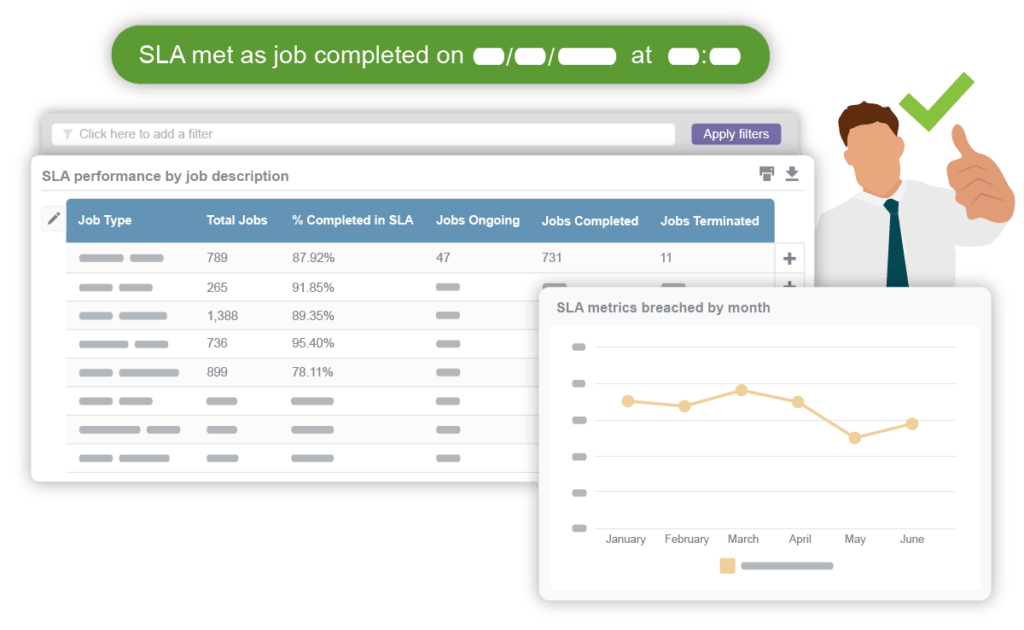The Guide to Creating a Property Maintenance Service Level Agreement!
April 30, 2025 | Read: 9 minutes

Managing property maintenance contracts can be challenging, especially when it comes to delivering consistent service that meets client expectations.
This is where a Property Maintenance Service Level Agreement (SLA) becomes invaluable.
An SLA sets clear performance benchmarks between your business and the client, ensuring everyone understands exactly what “quality service” means for the project.
But how do you set one up, and why are SLAs important?
While property maintenance companies may assume that completing work guarantees customer satisfaction, today’s competitive landscape means customer expectations are higher than ever.
This is why service level agreements are essential in the field service industry, particularly in a commercial B2B context for facility maintenance.
Let’s explore all you need to know:

What is a Property Maintenance SLA?
A property maintenance service level agreement is a legally binding section of a service contract where the provider agrees to specific standards of service.
SLAs are often part of a hiring contract; they are legally binding documents and come clear requirements and consequences in the case of non-compliance.
Whether you’re maintaining a corporate office building or responding to emergency repairs, an SLA clearly defines your responsibilities as a service provider.
For example, your SLA might guarantee:
- A response time of 8 hours for urgent repairs.
- Regular maintenance every 3 months for key assets.
- Restoring operational equipment within 48 hours of downtime.
As with any legally binding document, these terms have to be reviewed beforehand so that both the provider and the customer are aware of their rights and responsibilities.
When collaborating with clients to create a customised SLA that falls outside your standard terms, it’s crucial to ensure that all parties are confident in their ability to meet the agreed-upon conditions. This level of diligence not only strengthens client relationships but also enhances trust and reputation in the industry.
Failing to meet these commitments can result in financial penalties, contract cancellations, or even legal consequences. That’s why it’s essential to establish realistic performance standards your team can consistently deliver.
Basic SLA Agreements:
The table below shows an example of a basic property maintenance service level agreement.
In real-life situations, the commitments will likely be more complex, but this should give you an example of what you can expect when creating SLAs.
| Service Level Commitment | Fulfillment Criteria | Minimum Performance Required | Service Level Breach Consequences |
|---|---|---|---|
| Maintenance check visit for Asset #1 | Every 3 months | 99.9% | 5% Service Credit gained for each percentage under the specified Minimum Performance |
| Reactive technician visit | 8h from initial call | 90% | 5% Service Credit gained for each percentage under the specified Minimum Performance |
| Arrange repairs following technician visit | 12h | 90% | 5% Service Credit gained for each percentage under the specified Minimum Performance |
| Asset downtime | 48h from technician visit | 90% | 5% Service Credit gained for each percentage under the specified Minimum Performance |
Why Are SLAs Important for Property Maintenance Businesses?
SLAs go beyond ticking boxes on a contract. They’re essential for building trust, improving client retention, and avoiding costly disputes. Here’s how they help:
- Set Clear Expectations: SLAs outline exactly what clients can expect, fostering transparency.
- Improve Accountability: Measurable metrics clarify responsibilities for both parties.
- Enhance Client Satisfaction: With guaranteed standards in place, clients have fewer complaints and more confidence.
- Boost Efficiency: Predictable routines help your team plan and prioritize tasks effectively.
- Win More Contracts: A proven track record of SLA compliance makes your business more attractive to potential clients.
While property maintenance contracts are usually reviewed and renewed after a year or more, you can revise an SLA every quarter depending on performance, previous agreements between the two parties, or changes in services.
The flexibility of SLAs can be revised with less administrative effort than a full-blown contract.
Key Components of a Property Maintenance Service Level Agreement
Creating a robust property maintenance service level agreement requires careful planning. Here are the must-have sections to include when writing your agreements:
1. Summary of Terms
Quickly outline the scope of services, service standards, and the client’s expectations. This keeps both parties aligned from the outset.
2. Service Response Times
Define specific response times for different scenarios (e.g., same-day for urgent repairs, 48 hours for non-urgent issues). Exceeding these timelines may trigger penalties outlined in the SLA.
3. Deliverables & Requirements
List all services you will provide, along with client responsibilities like granting property access or approving repair costs. This ensures accountability on both ends.
When writing this section, list the specific numbers and goals that meet the customers’ terms and that your company can comfortably commit to.
4. Performance Metrics
Include measurable KPIs, such as technician response times, service quality ratings, and repair completion times. These metrics help track success and avoid disputes.
5. Penalty Structure
Nobody enjoys thinking about what will happen if a service or product fails – or worse, doesn’t get provided. However, customers will always like to know they’re protected and that you’re prepared to anticipate but also handle any expected situations.
Specify consequences for SLA breaches, such as:
- Financial penalties like service credits or payment deductions.
- Corrective action plans or increased monitoring.
- Termination of the contract for repeated violations.
6. Communication Protocols
Establish how clients can report issues, track job progress, or escalate concerns.
Include tools like online customer portals or automated status updates for maximum efficiency.
7. Periodic SLA Reviews
Allow for SLA adjustments based on performance data, seasonal demands, or new client needs. Quarterly reviews are a common practice among successful maintenance businesses and help grant valuable data you can use to help reassess and review SLAs.
Regardless of the type of business you run, you should have some sort of statistics on how your service and product will perform. Think about specific benchmarks and what information will be useful to your client.
8. Legal Guidelines
Cover liability terms, dispute resolution procedures, and insurance requirements to ensure both parties are protected.
By clearly defining these components, you’ll create a framework that minimizes misunderstandings and ensures smooth collaboration.
How to Draft a Property Maintenance SLA
Now that we understand what SLAs are, their importance, and the key components of one, it’s time to dive into the steps you should take when drafting a property maintenance service agreement.
Planned maintenance software can help your team organize all aspects of contract management.
Gather Information
Start by collecting essential client details, including business and owner name, address, contact information, preferred communication methods, and a contract reference number.
Define the Scope of Services
Clearly outline the services your company and technicians will provide. Specify routine tasks and any agreed additional services. This sets expectations and prevents misunderstandings.
Set Response Times
Define response times for each type of service, whether it’s an emergency repair or a routine call. Response times can help secure clients, and meeting these commitments is key to success.
Outline Performance Measurement
Include measurable metrics to track service performance, such as Key Performance Indicators (KPIs) like response time, resolution time, and customer satisfaction.
Establish Communication Protocols
Clearly state how clients can contact you (email, phone, or an online platform). If you monitor equipment, notify clients immediately if issues arise.
Address Cost and Payment
Detail the cost structure, including recurring fees, charges for additional services, and the payment schedule. Ensure no ambiguity about financial terms to avoid confusion.
Define Term and Termination
Specify the agreement’s duration and termination conditions, whether it’s a fixed-term or month-to-month contract. Make sure both parties understand the terms.
Include Standard Clauses
Add standard legal clauses to protect both parties, such as dispute resolution or confidentiality agreements. Consult legal professionals as needed to draft or update this section.
What Happens When Trade Companies Breach a Property Maintenance SLA?
Breaching an SLA can lead to financial penalties like deductions, fines, or withheld payments, as well as increased costs from performance improvement measures such as warnings, corrective action plans, or closer monitoring.
An SLA breach typically occurs when your service falls short of these agreed standards, whether due to delays, lack of expertise, or other issues.
Consequences for breaches must be outlined in the contract and should be carefully negotiated to ensure you can uphold the agreement and avoid penalties.
Repeated breaches may result in contract termination, damaging your reputation and making it harder to secure future clients.
In severe cases, legal action could occur, including lawsuits and further harm to your reputation. Adhering to SLAs is essential for protecting your business margins and long-term success.
Automate SLA Management with Facility Maintenance Software
Manually tracking SLAs across multiple properties can be overwhelming and error-prone. That’s where Facility Maintenance Software like Commusoft makes a difference.
Our SLA management tools allow you to:
- Automate SLA Tracking: Set reminders and receive alerts for SLA deadlines, reducing the risk of non-compliance.
- Analyze Performance: Gain actionable insights through performance reports and service metrics.
- Streamline Communication: Use automated notifications and customer portals to keep clients informed.
- Simplify Contract Management: Handle renewals, revisions, and multi-site agreements effortlessly.
With job management software like Commusoft, you can focus on delivering exceptional service while minimizing administrative burdens. Plus, clients appreciate the transparency and reliability that comes with automated workflows.

Transform Your Business with SLA Management
Without the right tools, contracts and SLAs can be easy to lose track of, especially as the scale and intensity of work increases with a growing business.
However, Service Level Agreements aren’t just another piece of paperwork; they’re a strategic tool for growth. By leveraging the right technology, you can improve client relationships, prevent costly mistakes, and set your business apart from competitors.
Curious how Commusoft can simplify SLA tracking and boost your efficiency?
Click below to discover our Service Contract Management Software and how it supports successful SLA compliance.

Anthony Vattimo
Thanks for checking out the Commusoft blog - I’ve been helping business owners improve their strategies for a few years now, so I hope you were able to take something away from the content I’ve written. Feel free to continue exploring the blog - or reach out to us with any questions!








